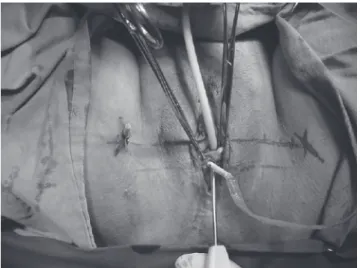433
CLINICS 2005;60(5):433-4
Division of Urology, Hospital das Clínicas, Faculty of Medicine, University of São Paulo - São Paulo/SP, Brazil.
Email: alexandre.danilovic@sbu.org.br
LETTER TO THE EDITOR
USE OF TRANSOBTURATOR SUBURETHRAL TAPE
FOR SURGICAL TREATMENT OF STRESS URINARY
INCONTINENCE IN A RENAL TRANSPLANT PATIENT
Alexandre Danilovic, Fabio Baracat, Nelson Íleo Dias Montellatto, William Carlos Nahas, and Antonio Marmo Lucon
Female stress urinary incontinence (SUI) is being treated successfully with placement of tension-free vagi-nal tape.1The use of synthetic mesh in renal transplant
pa-tients is rarely reported. No case of surgical treatment of SUI in a renal transplant patient using transobturator suburethral tape is listed on MEDLINE. The transobturator tape technique is a minimally invasive procedure that avoids the retropubic space by inserting a tension-free syn-thetic mesh underneath the middle of the urethra between the obturator foramens.2
DESCRIPTION OF THE CASE
A 56-year-old female presented with stress urinary in-continence for 2 months. She complained about episodes of urinary leaks during coughing or physical exercise re-quiring the use of 1 to 3 pads per day with a severe im-pact on her quality of life. No dysuria, urgency, nocturia, or sensation of postvoid residual urine was reported. She had 3 vaginal deliveries, an appendectomy 40 years pre-viously, and a renal transplantation in left iliac fossa 6 years previously to treat end-stage renal disease due to hypertension. At presentation, she was taking the follow-ing medications: mycophenolate mofetil 1500 mg/d, cyclosporin 150 mg/d, prednisone 7.5 mg/d, atenolol 100 mg/d, captopril 50 mg/d, and simvastatin 10 mg/d. The physical examination revealed a renal graft in left iliac fossa, trophic vaginal mucosa, and no pelvic organ pro-lapse. Urethral hypermobility was demonstrated with a positive Crystle test3, and urine loss was 40 g/24-hour
measured using a pad weighing test. The urine culture was negative, and plasma creatinine was 0.9 mg/dL. Urodynamic evaluation showed a bladder capacity of 480 mL, normal compliance and sensation, absence of detru-sor overactivity, Valsalva leak point pressure of 80 cm H2O, maximal flow rate of 9.3 mL/s, and detrusor pres-sure at maximal flow of 12.3 cm H2O.
A tension-free polypropylene tape was inserted under regional anesthesia, and antibiotic prophylaxis with cefazolin at induction was used. The tape was inserted in a horizontal plane underneath the middle of the urethra be-tween the obturator foramens via an inside-out technique4
(Figure 1) and was followed by cystoscopy to confirm ab-sence of bladder injury. The procedure was uneventful and lasted 25 minutes, with an estimated blood loss of 20 mL. The patient was discharged the next day after spontaneous micturition. At a 30-day follow-up, no stress urinary incon-tinence, pads uses, or voiding difficulty was reported.
434
CLINICS 2005;60(5):433-4 Use of transobturator suburethral tape for surgical treatment of stress urinary incontinence
Danilovic A et al.
DISCUSSION
The transobturator suburethral tape is a novel technique that is being applied for surgical treatment of SUI.2,5 There
are no listed MEDLINE reports on this technique for a transplant patient. This approach prevents the risk of blad-der, bowel, or vascular injuries because it avoids the retro-pubic space. Although we performed an endoscopic evalu-ation, there is no need for cystoscopy, which reduces op-erative time.2,5 Renal transplant patients particularly
ben-efit from these advantages because the procedure avoids the theoretical risk of graft injury. No urinary or surgical site infection occurred in this case, despite the use of syn-thetic mesh in this immunosuppressed patient. Previous data on the use of synthetic material in transplant patients revealed low rates of infection.6 The inside-out
transobturator technique for insertion of a suburethral tape is a good option for the treatment of SUI in renal trans-plant patients because of its minimally invasive character and low rates of complications.
REFERENCES
1. Abouassaly R, Steinberg JR, Lemieux M, Marois C, Gilchrist LI, Bourque JL, et al. Complications of tension-free vaginal tape surgery: a multi-institutional review. BJU Int. 2004; 94: 110.
2. Delorme E, Droupy S, deTayrac R, Delmas V. Transobturator tape (Uratape): a new minimally-invasive procedure to treat female urinary incontinence. Eur Urol. 2004; 45: 203.
3. Crystle CD, Charme LS, Copeland WE. Q-tip test in stress urinary incontinence. Obstet Gynecol. 1971;38(2):313-5.
4. deLeval J. Novel surgical technique for the treatment of female stress urinary incontinence: transobturator vaginal tape inside-out. Eur Urol. 2003; 44(6):724-30.
5. deTayrac R, Deffieux X, Droupy S, Chaveaud-Lambling A, Calvanese-Benamour L, Fernandez H. A prospective randomized trial comparing tension-free vaginal tape and transobturator suburethral tape for surgical treatment of stress urinary incontinence. Am J Obstet Gynecol. 2004; 190: 602.
